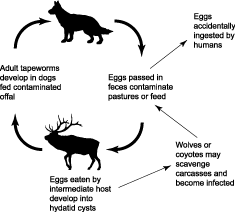| | The tapeworm Echinococcus granulosus occurs worldwide, and it is a major concern to many livestock raising countries. The larval stage of this tapeworm is referred to as a hydatid and is a serious problem for both livestock economics and public health.
Two life cycle patterns of the cervid strain of E. granulosus occur in Alberta: a sylvatic cycle (the cycle that occurs in wildlife) and a domestic cycle (the cycle that occurs under farm conditions).
In the wild, the adult tapeworm develops in the wolf and occasionally coyotes and other members of the dog family (Canidae). The larval stage develops in moose, caribou and elk (wapiti).
In the domestic cycle, the adult tapeworm develops in dogs and the larval stage primarily in farmed elk. Both the sylvatic and domestic cycle provide a potential for exposure to humans.
Producers should be aware of this tapeworm to protect their livestock and reduce the risk of transferring the infection to dogs, themselves and their families.
Life cycle of Echinococcus granulosus under game-farm conditions
Dogs fed the viscera (intestines and other organs) from elk containing hydatid cysts may become infected with Echinococcus. The adult tapeworm takes 6 to 7 weeks to develop in the dog's intestine and begin passing eggs. The tapeworm eggs shed in the feces of dogs contaminate pastures, lawns and gardens and can stick to dog's fur.
The eggs are microscopic and cannot be seen with the naked eye. The adult tapeworm lives for about 2 to 3 years and continues shedding eggs that survive for several months on pasture.
Elk are intermediate hosts in the life cycle of this tapeworm. They become infected when they eat eggs passed by infected members of the dog family. Ingested eggs hatch in the intestine of elk, and the released larva (oncosphere) penetrates the intestine and is carried by the bloodstream to various organs throughout the body. The lung is the most common site for hydatid development in elk, but other organs may also contain hydatid cysts.
The hydatid undergoes internal budding to produce hundreds or thousands of infective forms called protoscolices, each capable of developing into an adult tapeworm when eaten by a dog (Figure 1).

Figure 1. Life cycle patterns
In elk
What do I look for in elk?
The hydatid grows slowly. Small cysts may not be visible in the lung or other organs at slaughter. Older cysts are several centimeters in diameter and form palpable nodules in the lung or light colored swellings that protrude from the surface of the liver.
How are elk affected?
Elk of all ages are susceptible to infection. The hydatid cyst does not cause serious health problems when only a few cysts are present. The main pathogenic effect occurs as the hydatid grows and displaces organ tissue.
What economic losses occur?
The main economic loss occurs when organs are condemned at slaughter.
In dogs
What do I look for in dogs?
The adult tapeworm is 3 to 6 mm long and is the smallest tapeworm found in dogs. There may be several hundred worms present in the small intestine of a dog.
How does it affect dogs?
Light infections do not produce disease. Inflammation of the intestine may occur when many tapeworms are present resulting in diarrhea, weight loss or a rough coat.
In humans
People become infected accidentally by ingesting the tapeworm egg. People who pet the fur of a contaminated dog may accidentally transfer an egg from the dog's fur to their mouth and infect themselves. When people ingest the egg of this tapeworm, a hydatid may develop producing a potentially dangerous condition known as hydatidosis.
How does it affect humans?
Hydatid cysts generally do not cause clinical symptoms unless the cysts are numerous, become very large or occupy organs such as the brain or eye. Speak to your physician about treatment if you are concerned you may be infected.
How can I prevent infection on my farm?
- Do not feed your dog the viscera from any farmed or wild animal including elk, deer and moose.
- Keep dogs away from areas where animals are being slaughtered.
- Dispose of offal to prevent it from being eaten by dogs or wild canids.
- Wash your hands after handling pets to prevent accidental ingestion of the infective eggs.
- Ask your veterinarian to examine your dog for Echinococcus and treat any infected animal. Dogs should be confined during the treatment interval, and all feces should be incinerated.
- Become familiar with the dangers and method of spread of hydatid disease.
Agdex 481/655-1. July 2004. |
|